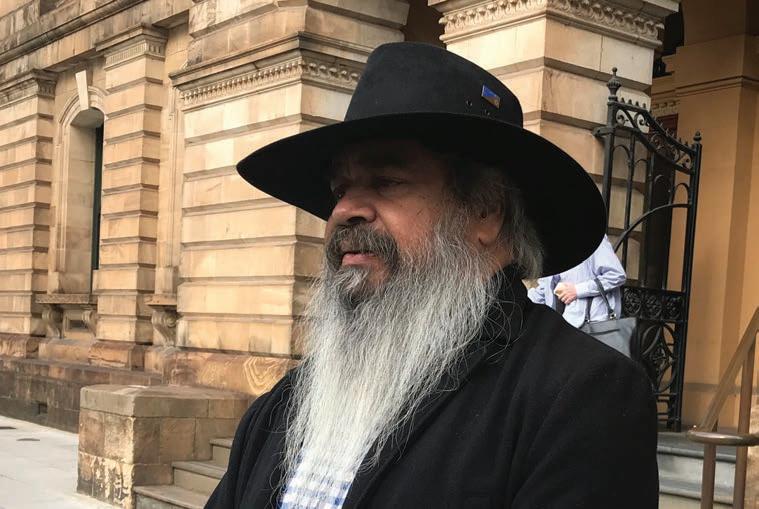
23 minute read
Inside: Traditional owners want a say on nuclear waste
Traditional owners in areas where the Federal Government proposes to locate a nuclear waste storage facility have expressed their opposition to the plan, with one group taking their concerns over the consultation process to the Supreme Court and Australian Human Rights Commission.
The Federal Government shortlisted the Kimba council area for two of three potential sites for Australia’s radioactive waste facility, and the Kimba District Council had planned a ballot of local ratepayers as a further step in the consultation process.
Advertisement
The Barngarla Determination Aboriginal Corporation lodged an injunction to halt the ballot with the Supreme Court, arguing that it unfairly excluded native title holders who have native title rights in the area but do not live within the council boundaries.
Barngarla Determination Aboriginal Corporation co-chairperson Emma Richards told the Eyre Tribune that Barngarla native title holders just wanted to be included in the vote.
“The traditional owners are connected to the land... so they should be included in any vote or consultation anywhere in their lands and seas” she said.
In the initial injunction hearing, the Court heard the majority of the around two hundred native title holders lived outside Kimba District Council.
The lawyer for the Barngarla Determination Aboriginal Corporation, Daniel O’Gorman SC told the court his clients did not want to stop the ballot, just to be included, as were ratepayers who might live outside of the area.
“That’s all they want, they just want to be included, they don’t want to be treated any differently because their rights are Aboriginal rights” he said. Michael Burnett, representing the District Council of Kimba, told the court that the council wanted to conduct the vote in a fair manner and decided the way to do that was to comply with the Local Government Act.
He said that the vote was not binding, but consultative only.
“It’s not a vote that has direct consequences… it’s part of a range of consultations that will be taken into account” Mr Burnett said.
The Court granted an injunction until a hearing before the Full Court, delaying the original planned start of the ballot of around eight hundred Kimba residents.
Vince Coulthard outside the Supreme Court.
At the second hearing, lawyers for the Barngarla people further argued that the poll was in breach of the Racial Discrimination Act and stated that they had lodged a complaint with the Australian Human Rights Commission.
The matter was referred to the Australian Human Rights Commission for a conciliation between the Kimba District Council and the Barngarla Determination Aboriginal Corporation.
The other potential location for the nuclear waste site is also in South Australia, at Barnidoota in the the Flinders Ranges, on Adnyamathanha country.
Outside the court on the day of the Full Court injunction hearing, the CEO of Adnyamathanha Traditional Lands Association (ATLA), Vince Coulthard told Aboriginal Way that a similar vote planned by the Flinders Ranges Council had the same issues for his people.
“We’re in the same situation as to Barngarla people, because Adnyamathanha people have been excluded from the vote, just like the Barngarla people. “Like the Barngarla people, only very few of us live in the 50-kilometre radius, or, in Barngarla’s case, the township of Kimba, but for us the 50-kilometre radius of the Barndioota” he said.
“But we’ve been excluded from the voting process. I’ve got Adnyamathanha people to make submissions and fill out the applications for a chance to vote in this exercise, because we have got a say; never mind whether we live in the area, we should have a right to say what happens on our country. We have occupied this land for thousands of years so that gives us a right, more so than some of the people that have been here for 150 years, 200 years, I would have thought.
Barngarla members joined representatives from organisations including the Adnyamathanha Traditional Lands Association, SA Greens and Conservation Council SA for a protest against the planned facility on the Joy Baluch Bridge in Port Augusta on Sunday 19 August.
After the injunction, the Flinders Ranges Council announced that it would also defer its planned ballot until resolution of the matter.
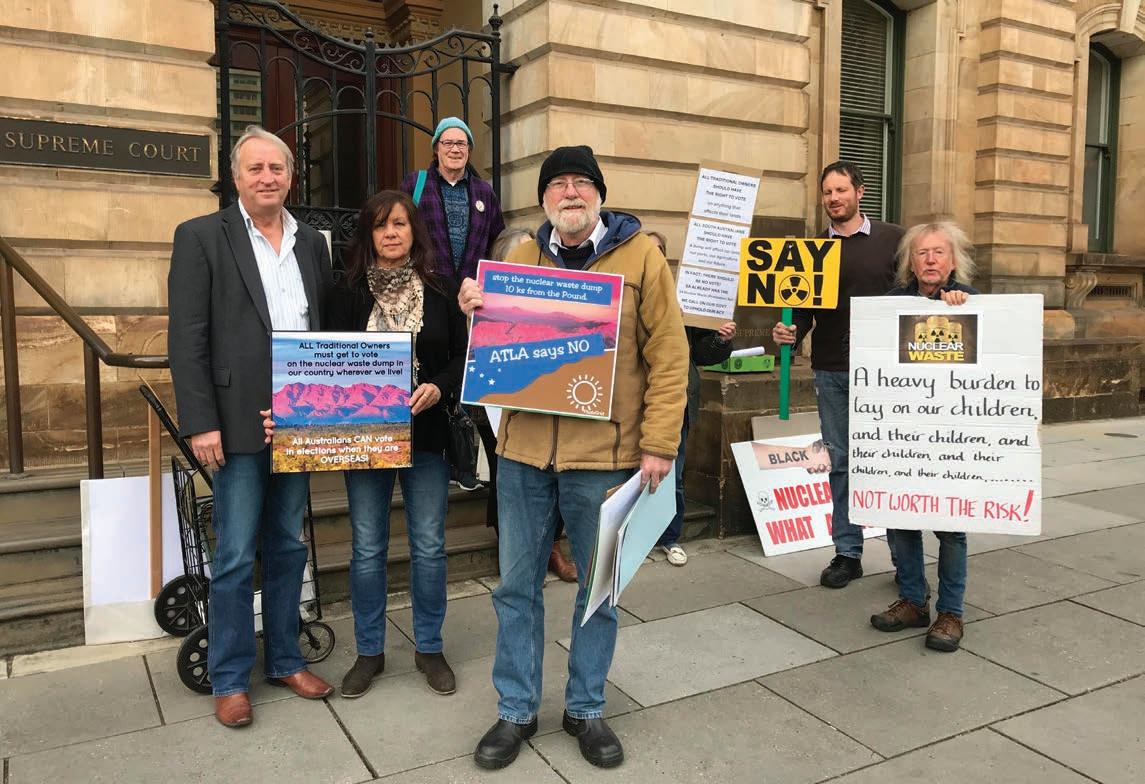
On 27 September, the Kimba District Council announced that the matter could not be resolved in the Australian Human Rights Commission.
“The Australian Human Rights Commission has today formally terminated conciliation between the Barngarla Determination Aboriginal Corporation and the District Council of Kimba. The matter is now likely to proceed through a judicial process. In the meantime, the National Radioactive Waste Management Facility site selection ballot will not be undertaken until the matter is resolved” the Council said in a statement.
On 28 September, the Department of Industry, Innovation and Science, which holds responsibility for the establishment of the radioactive waste site, said that while the ballot was on hold, their engagement on the site would continue.
“Consistent with its commitment to the communities, the department will continue to work to ensure the views of the community, including traditional owners, are heard, and a decision on the nominated sites is made this year.
“Community consultation is central to this process, and the department is continuing to actively seek views about the National Radioactive Waste Management Facility. As the legal case between the two parties remains ongoing it is not possible at this point to fix a date for the closure of the consultative processes.
“The Government continues to work to hear the views of all community members, including local residents, neighbours, business owners and traditional owners.
“This includes our direct work with Aboriginal communities both for and against the proposal, and surrounding all three sites currently under consideration.”
On 19 October the Barngarla people’s complaint was scheduled for trial in the Federal Court on 30 January 2019.
“This provides a streamlined approach to be able to have those conversations and convey the messages from our groups and our people to the government in regards to the issues that we are experiencing, the problems we have and the ideas we have for the future – our own development and our own opportunities.
“The body also provides an opportunity for Aboriginal Nations to learn from each other” Mr Thomas said.
“I believe it’s also a great place for ideas to be shared amongst the different groups, solutions to problems, often the problems we find are found in other areas and often there are solutions or be able to assist us with our own issues or vice versa so in that regard I believe it’s a fantastic start” he said.
“While native title groups and other Aboriginal nations will collaborate in the new organisation, it will not take on any of the individual decision making that now happens in individual communities” Mr Thomas said.
“It’s designed to be a conduit, to take the voice of groups forward and present it to government and departments. The group manages itself as they always have, this is an avenue for whoever they decide to appoint to represent them in a more direct and easy manner, so hopefully their concerns are heard” Mr Thomas said.
Ms Merrick said that the new organisation is a valuable addition to the governance structures for Aboriginal organisations in the state.
“This doesn’t replace the PBCs. This enhances the governing structure for South Australia, and it’s an opportunity for us to escalate and advocate for the issues, the common issues that we have as Prescribed Bodies Corporate” she said.
The new corporation will receive support and some funding from South Australian Native Title Services (SANTS) and will seek further sources of revenue.
Tom Jenkin, Manager of Corporate and Community Development at SANTS said the decision by delegates is a great outcome.
“It’s a positive and significant decision for native title groups to come together and establish a representative peak body to work for the collective interest and benefits of their communities and others across the state” he said.
“The decision has been made in a considered and informed manner and there is much enthusiasm for the future of this new organisation.
“It will give Aboriginal Nations a chance to collaborate and lead discussions on shared issues and opportunities, including relevant reforms to government policies, programs and legislation. It provides a framework for leader to leader dialogue at a state level, to communicate and drive an Aboriginal-led agenda, and to realise many long-desired changes and opportunities” Dr Jenkin said.
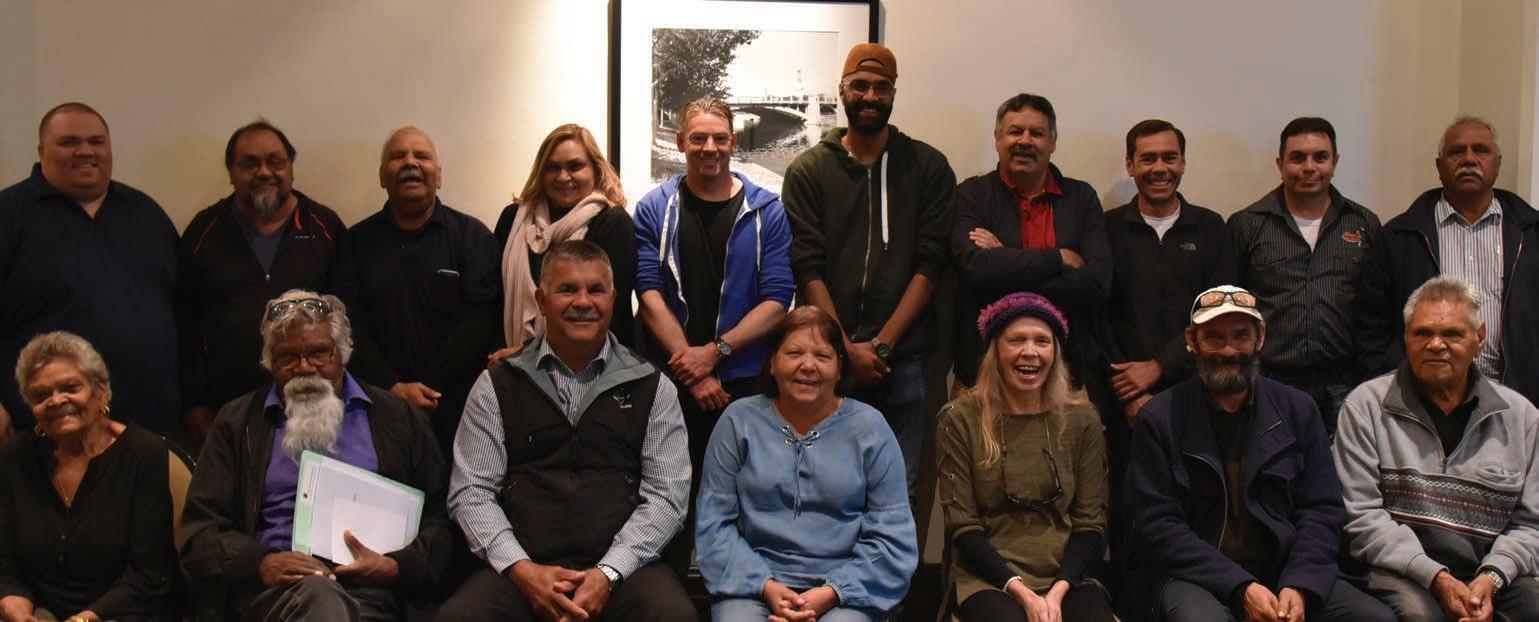
Representatives of South Australian Aboriginal Nations at the meeting on 10 October 2018.
Aboriginal corporation and native title laws under review
The law that governs how native title holders and other Aboriginal corporations manage their affairs, the CATSI Act is currently under review by the Federal Government.
The Corporations (Aboriginal and Torres Strait Islander) Act 2006 (CATSI Act) guides how Aboriginal and Torres Strait Islander corporations are run.
Once a native title group gains native title recognition, they must form a Prescribed Body Corporate (PBC) and register that under the CATSI Act.
The Act includes guidance on:
• The level of reporting required;
• What records must be kept by PBCs;
• Duties of directors and managers;
• Member rights; and
• The role of the Registrar and special administration.
The CATSI Act has similarities with the Corporations Act 2001 (Cth), which governs all companies in Australia, but was created for the particular needs of Indigenous corporations.
It includes specific provisions for Registered Native Title Bodies Corporate (RNTBC) to ensure that their obligations under the Native Title Act don’t conflict with the requirements for their corporations.
The Federal Government has released an options paper and held national forums on proposed changes to the CATSI Act.
ORIC, the Office of the Registrar of Indigenous Corporations managed the review and consultation.
In a summary of the proposed changes they explain what changes are needed and why they have been proposed.
• Size classifications
• Rule books
• Prohibited names
• Business structures
• Meetings and reporting • Transparency of senior executives
• Related third parties
• Special administration
• Voluntary deregistration
• Compliance powers
The initial consultations have been completed and the next steps in the reform are underway. On 29 October, the Federal Attorney-General Christian Porter released an ‘exposure draft’, a proposed version of the Native Title the Native Title Legislation Amendment Bill 2018 and the Registered Native Title Bodies Corporate Legislation Amendment Regulations 2018.
The Government said that the amendments contained in the exposure drafts are intended to improve the native title system for all parties by:
• Streamlining claims resolution and agreement-making processes;
• Supporting the capacity of native title claimants through greater flexibility around internal decision-making; • Increasing the transparency and accountability of prescribed bodies corporate (the corporations set up to manage native title) to the native title holders;
• Improving pathways for dispute resolution following a determination of native title; and
• Ensuring the validity of section 31 agreements in light of the Full Federal
Court of Australia’s decision in
McGlade v Native Title Registrar & Ors [2017] FCAFC 10.
More information on the reforms process, including the exposure drafts, is available on the Attorney-General’s Department website and on indigenous.gov.au.
Submissions close on 10 December 2018.
For further information on the review and changes see the ORIC website: oric.gov.au/catsi-review
For further information on the CATSI Act see the PBC website: nativetitle.org.au/learn/native-titleand-pbcs/oric-and-catsi-act

Kaurna community members laid to rest the remains of two of their Old People repatriated from museums in Europe in an emotional ceremony at Tennyson Dunes near West Lakes recently.
For many years the ancestral remains of South Australian Aboriginal Nations were collected by museums and universities across Australia and the world for ‘scientific’ research.
In recent years the Australian government and international museums have taken steps to return the remains to their ancestors.
“The Old People were often taken without consent, which caused great sadness and anger, and that has been carried for generations” said Kaurna Elder Jeffrey Newchurch.
“While past wrongs can’t be forgotten, pathways to healing can now start” he said.
Elders Fred Agius, Jeffrey Newchurch, Moogy Sumner and Tamaru Kartinyeri with Katrina Karlapina Power participated in a smoking and burial ceremony to return the Old People home to where their spirits lie.
Traditional owners had met the remains in Canberra and escorted them back to Kaurna country for the burial.
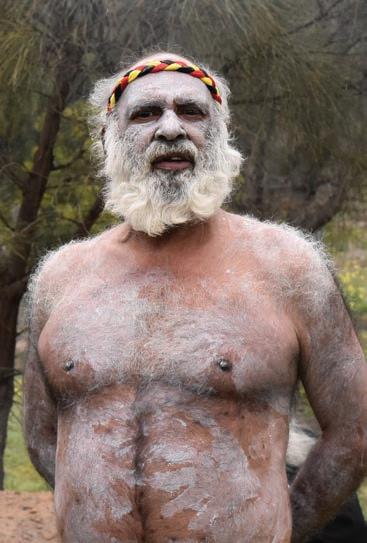
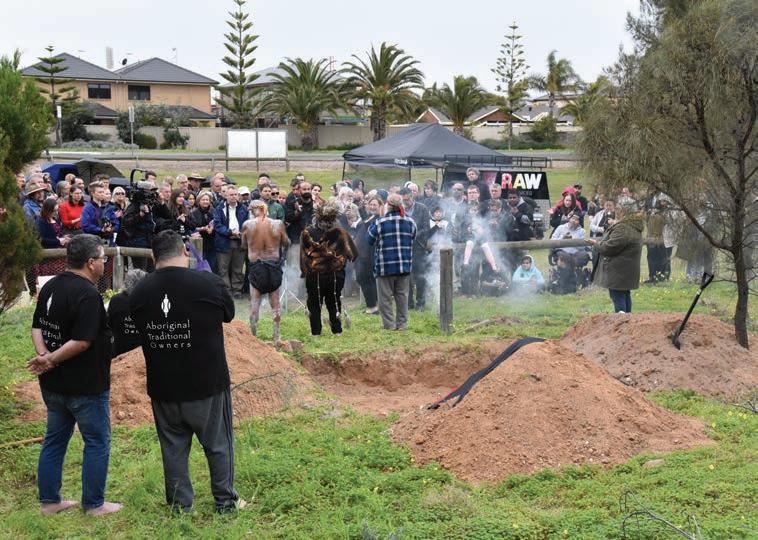
Top: Katrina Karlapina Power and Jeffrey Newchurch. Bottom from left: Fred Agius; The reburial ceremony at Tennyson Dunes; Fred Agius and Katrina Karlapina Power.
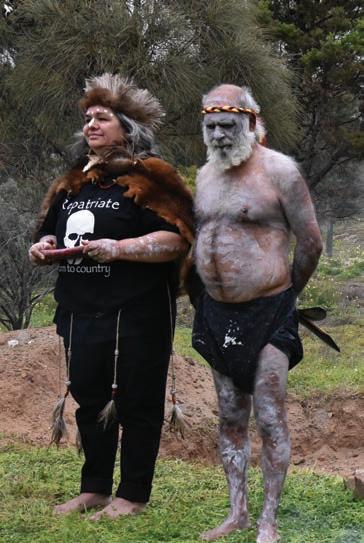
A native title compensation case could set a precedent for future compensation claims, in the first High Court hearing to take place in the Northern Territory.
In early September, people gathered in Darwin to witness a three-day hearing where evidence was provided by the Ngaliwurru and Nungali people of Timber Creek, and the Federal and Northern Territory Governments. The case was first heard by Justice Mansfield in 2016, who ordered the Ngaliwurru and Nungali people be paid compensation of $3.3 million from the Northern Territory Government. The Norther Territory Government then appealed the decision arguing that the loss of native title rights had been overestimated.
The native title holders say that their loss of native title rights should be at least the same value as what the entire freehold land is worth.
The Territory and Federal governments say it should be worth no more than 50 percent of the land value.
During the recent hearing, the High Court emphasised the complex nature of valuing spiritual connection to the land. Justice James Edelman asked whether the spiritual value of the land could not also be of economic value, in the same way ‘ocean views’ might add value to freehold land.
During the 1980s and 90s Timber Creek underwent significant development which extinguished some of the Ngaliwurru and Nungali’s native title rights and interests.
Initially, Justice Mansfield arrived at $3.3 million by calculating three different types of loss – economic loss, interest on that economic loss and non-economic loss. Economic loss, the value of the land, was estimated at $512,000. $1.48 million was the interest calculated on that loss since extinguishment.
SANTS Deputy Principal Legal Officer, Osker Linde said the High Court’s pending decision will help shape the future of native title compensation.
The decision “impacts future compensation claims by having the High Court deliver authority on how native title compensation applications are to be assessed and valued. We will hear whether the trial judge’s approach was best. i.e. splitting economic and non-economic loss”.
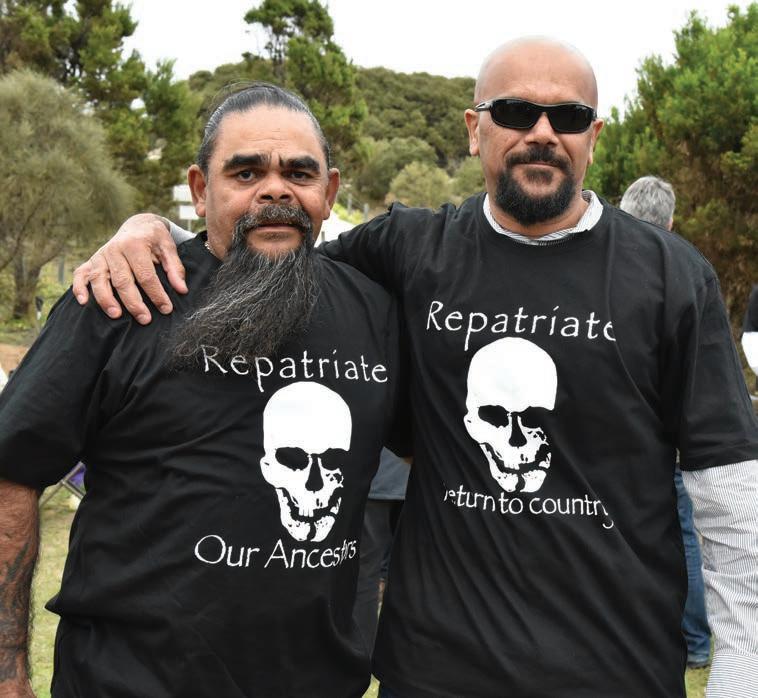
At the reburial ceremony, the remains of the Old People were taken from their storage boxes and placed in Kaurna soil uncovered and facing Kangaroo Island, according to tradition.
The processes and practices of repatriation and reburial are important for the cultural learning of young Kaurna People and non-Aboriginal people the Kaurna leaders said.
“We welcome our Old People home. We show them respect. We show all respect because we are Kaurna” said Uncle Fred Agius at the conclusion of the ceremony.
One of the ancestors, the Port Adelaide Old Person was returned from the Karolinska Institute in Stockholm, Sweden earlier this month.
The remains were collected by Captain Nils Werngren from Port Adelaide during his second sea voyage around the world 1842 to 1844. On his return, he donated this and other remains to the Institute, which has held a large collection of human skeletal remains since the 19th century.
A second Old Person, from Henley Beach, was returned from the National Museum in Canberra, where the remains were held since 2009, after being returned from the Pathology and Natural History Museum in Vienna, Austria.
While welcoming the return of their ancestors, both Jeffrey Newchurch and Katrina Karlapina Power called on South Australia’s own museum to consider their own collection.
“There currently appears to be ancestral remains of over 800 Kaurna old peoples held at the South Australian Museum’s bulk story” said Mr Newchurch.
“This is disrespectful and wrong” he said.
“1993 saw Museums Australia introduce its ‘Previous Possessions, New Obligations’ policy aimed a facilitating the return of human remains to aboriginal people. The return of Kaurna human remains from the SA Museum has not really started” Ms Power said.
“It is time for the SA Museum to have productive discussions with the Kaurna Nation about repatriation of Old People and the return of stolen Kaurna artefacts” she said.
For Mr Newchurch, the work continues.
“I have been working for many years on the return of Kaurna old people and one day I hope all ancestral remains of the Kaurna old people will be returned to Country” he said.
Native title claims update for South Australia
There are currently twenty active native title applications in South Australia.
The next claim that is likely to be determined is an overlap between the Adnyamathanha Peoples, Wilyakali Peoples and Ngadjuri Nation in the state’s north east.
This claim is set to be determined at the end of this year.
Other claims likely to be resolved this year include Narungga Nations and Nukunu.
The State is still considering supplementary evidence for Narungga Nations and negotiations for co-management of Innes National Park have also commenced.
The Nukunu claim which covers parts of the Eyre Peninsula near Port Lincoln, was listed for trial on 8 October, however the matter is now in case management.
The First Nations of the South East No.1 and No.2 and Ngarrindjeri, whose country is around the Coorong district, recently had successful mediation.
The overlapping Walka Wani and Arabana No.2 Claims for an area near Oodnadatta is listed for hearing in late 2019.
Other active claims include; Nauo/Nauo No.2/Nauo No.3, Wirangu No.2 and the Far West Coast Sea Claim on the Eyre Peninsula.
The Malyankapa claim in the state’s north east is also active.
Ngadjuri No.2 and Wilyakali and the Port Augusta overlaps (Kokatha No.3, Barngarla and Nukunu) claim currently have no priority matters.
The First Nations of the South East Claim No.1 and No.2 cover areas near Keith to the coast and across to the Victorian border. The claim was authorised by the community at a meeting in Mount Gambier and lodged on 4 August 2017.
The Nauo No.3 claim, over an area on the west coast of Eyre Peninsula was lodged on 16 March 2018.
A further sea claim is set to be filed by the Wirgangu people, which will take it up to 21 claims on file in South Australia.
On Friday 19 October, the High court of Australia refused three applications for special leave to appeal against the dismissal of native title claims over Lake Torrens. This concludes all legal proceedings.
South Australia saw three determinations of native title and one determination of compensation for loss of native title rights and interests last financial year.
On 28 September 2017, the Dieri No.3 claim was determined over the entire claim area, which sits along the eastern coast of Lake Eyre.
The Ngarrindjeri and Others Native Title Claim was determined over part of the original claim area near the Coorong in a hearing of the Federal Court in Murray Bridge on 14 December 2017.
Expected litigation was avoided and the Kaurna Peoples Native Title Claim over an area around Adelaide was determined by consent in the Federal Court in Adelaide on 21 March 2018.
The Tjayuwara Unmuru claimants received compensation for loss of their native title rights in a consent determination on 20 December 2017. The terms of the settlement remain confidential.
Mr Linde said that if the case leads to a loss for the traditional owners, this could mean a loss for all native title holders claiming compensation.
“It could potentially lead to a greater award of compensation for the people of Timber Creek, however it could potentially lead to a further reduction in the economic loss component for non-exclusive native title, although that is unlikely in my view.
“If that was the case, one could presume that it would create a new precedent Australia-wide, if the principle of separating out heads of compensation into economic and non-economic loss holds. For example, it could further reduce the percentage of market value of a freehold property that non-exclusive native title is worth. The present situation is that, the Full Court of the Federal Court reduced the formula from 80% to 65%.”
Interested parties, including Queensland, Western Australia and South Australia made submissions to the High Court, supporting the Territory and Federal Government’s position. “There are currently no compensation claims before the courts in South Australia. Two claims have previously been settled through mediation. The outcome of the High Court case could greatly influence how any future compensation claims in the state are brought and prosecuted” Mr Linde said.
Traditional owners from the Ngaliwurru and Nungali travelled to Darwin to attend the hearing.
Chris Griffiths and Lorraine Jones spoke outside court on behalf of the compensation claim group. “This court hearing, it makes us feel sad, it makes us happy and it also makes us proud because we know that our message is getting across, that they are understanding how important [it is that] we are connected to country and the land” Mr Griffiths told the ABC.
Mr Griffiths’s father was the lead applicant in the case and had recently passed away.
“Going to court makes my old man, who’s probably sitting in heaven right now looking down on us, smiling that we got this far,” he said.
Elliston community recognises the past
The Elliston community have recognised the site where Aboriginal people were killed at Waterloo Bay nearly 170 years ago.
Two large plinths now stand as a reminder to those who walk a new coastal trail, that a massacre took place there in 1849 – 169 years ago and claimed the life of around 200 local Aboriginal people. Around 200 people attended the official launch of the coastal trial and memorial in September, including Senator Patrick Dodson, who spoke about the importance of recognising history as it happened. “It is significant for the first nations community and for the wider community – it is hard to get to the truth and for it to be transformative and for us to do things, not out of guilt or shame or despair but out of hope and with a joint purpose. “This little town has come to grips with what has happen and so it’s a mutual form of liberation for people” Senator Dodson said.
Jack Johncock, Wirangu Elder, said it took a lot of work and collaboration to make the project a success. “It has been 40 years since a proposal was first made to the Elliston Council to put up a monument that recognises the massacre, but people were in denial. “It has taken until now for the community to work together and acknowledge the past. The council worked hand in hand with the community and our voices were
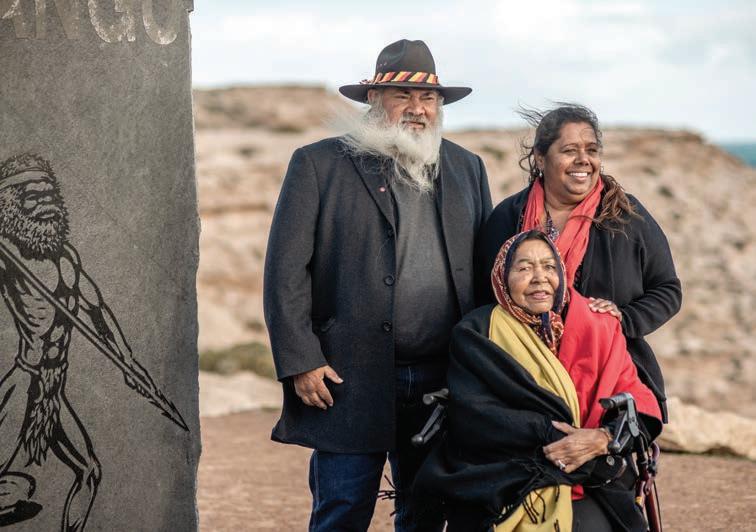
Senator Patrick Dodson, Wirangu Elder Veda Betts and Susie Betts.
heard. Everyone was happy to listen to each other and there was lots of dialogue and support” he said. Mr Johncock said that the launch of the memorial was an “exhilarating experience and that it was the result of a lot of hard work”.
George Karvis, Elliston Council Community and Engagement Officer said it was a special day.
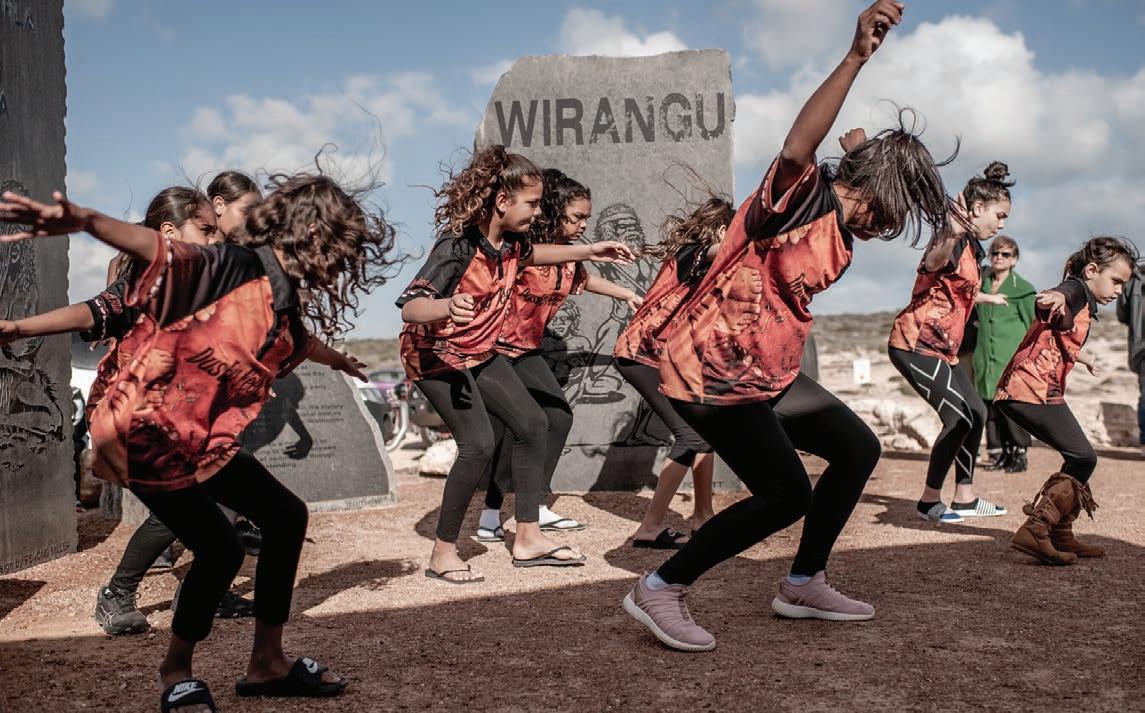
Dusty Feet Mob performing at the Elliston Memorial launch. Photos by SA Rips. “I couldn’t be happier with the day; the Dusty Feet Mob were spectacular and the service at the monument was incredibly touching and a very special moment”.
Mr Karvis said he was proud with how people came together for a moment of reconciliation.
“At the end of the day, the community got involved and participated in the event by helping with the cooking and organising. It was all hands-on deck once the majority of the elected members voted for the memorial” he said.
Mr Jody Miller, a Nauo and Wirangu man, has previously told Aboriginal Way that the tragedy at Waterloo Bay included people from clans across the area.
“The monuments are there now, acknowledging the Wirangu on one end and acknowledging the other clan groups of the area on the other. Nauo people were involved, as were their neighbours the Kokatha people” he said.
Aboriginal Regional Authorities on hold for State Aboriginal Affairs Action Plan
South Australia’s Aboriginal Regional Authority policy has been discontinued, leaving the role of three existing Regional Authorities on hold pending the development of a State Aboriginal Affairs Action Plan.
The Adnyamathanha Traditional Lands Owners Association (ATLA), the Ngarrindjerri Regional Authority and the Far West Coast Aboriginal Corporation signed Regional Authority agreements with the former state government early in 2017.
At the time, the then Minister for Aboriginal Affairs Mr Kyam Maher said that the policy “is a commitment to work more collaboratively with Aboriginal communities”. With the release of the State Budget in September came news that the policy had been discontinued by the new government. The Premier Mr Steven Marshall confirmed during Budget Estimates later that month that the Government continues to recognise the three Aboriginal Regional Authorities that have been established.
He said that the agreements setting them up remain in place and funding allocated under those agreement has been paid. A government spokesperson told Aboriginal Way that “the three regional authorities have been advised that pending the development of a State Aboriginal Affairs Action Plan by the end of this year, further engagement between the Government and the authorities is on hold”. Mr Marshall spoke about the State Aboriginal Affairs Action Plan in more detail at the Estimates Committee in State Parliament.
He said that engagement for the Plan would be efficient and the timelines for action to take place relatively short.
“The feedback I have received is that this is a sector that has been consulted many times. What they are looking for is some action and an action plan, and they would like to see an action plan that is not aspirational ‘This is what we are going to achieve over the next 60 or 70 years’ – but what can be done immediately.
“One of the disciplines we have put on ourselves is for the action plan to last two years and that we should be able to look at every one of the items on the action plan and say that we have either achieved it or not achieved it.
The Premier said that Dr Roger Thomas, previously Treaty Commissioner, now Commissioner for Aboriginal Engagement, would be preparing the Aboriginal Affairs Action Plan. “He is obviously going to be speaking with the state Aboriginal Advisory Council and other representative groups in the state. “But the critical thing is that we do not want to have a five-year hiatus going out to consultation. Quite frankly, many people have been able to make very sensible suggestions about things that we can do immediately” the Premier said. The Premier told Budget estimates that the Plan would be released and publicly available before Christmas.




